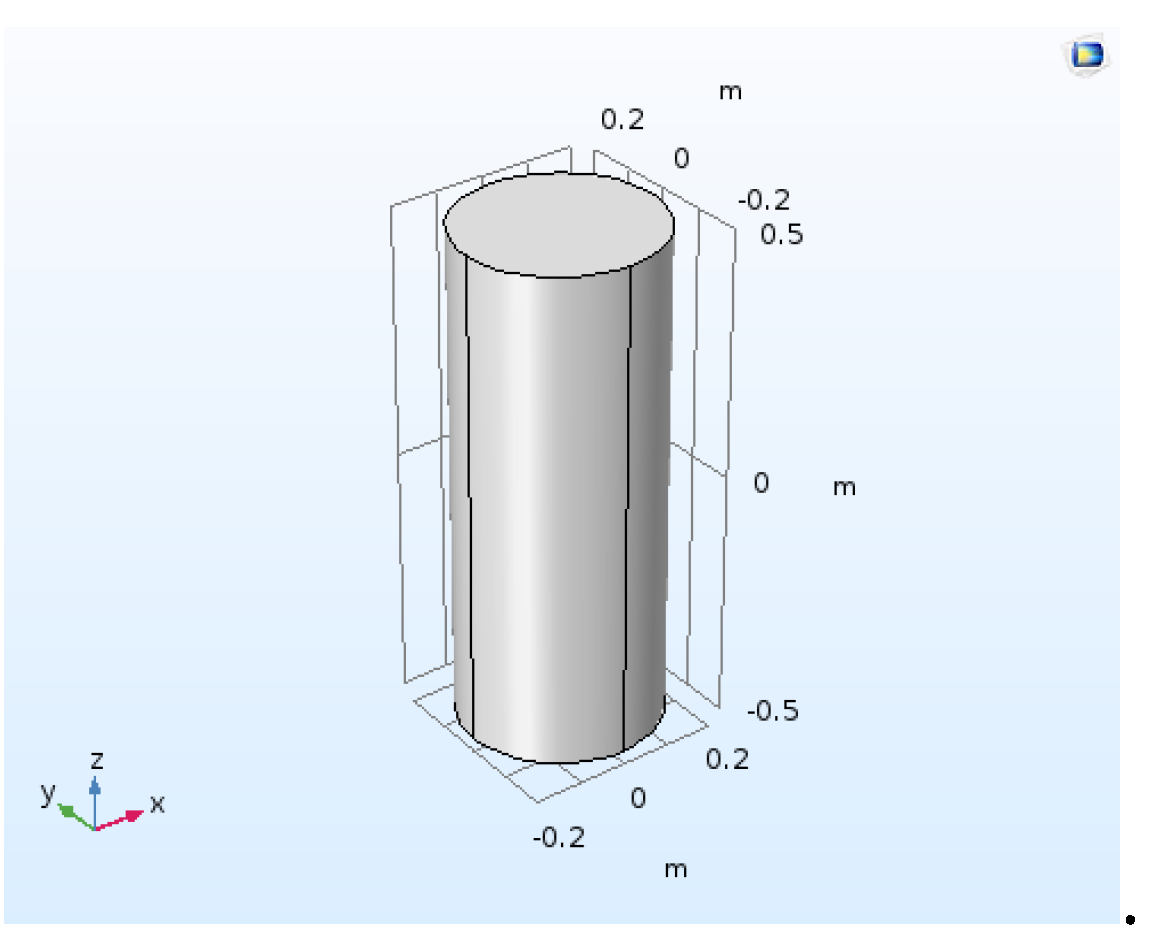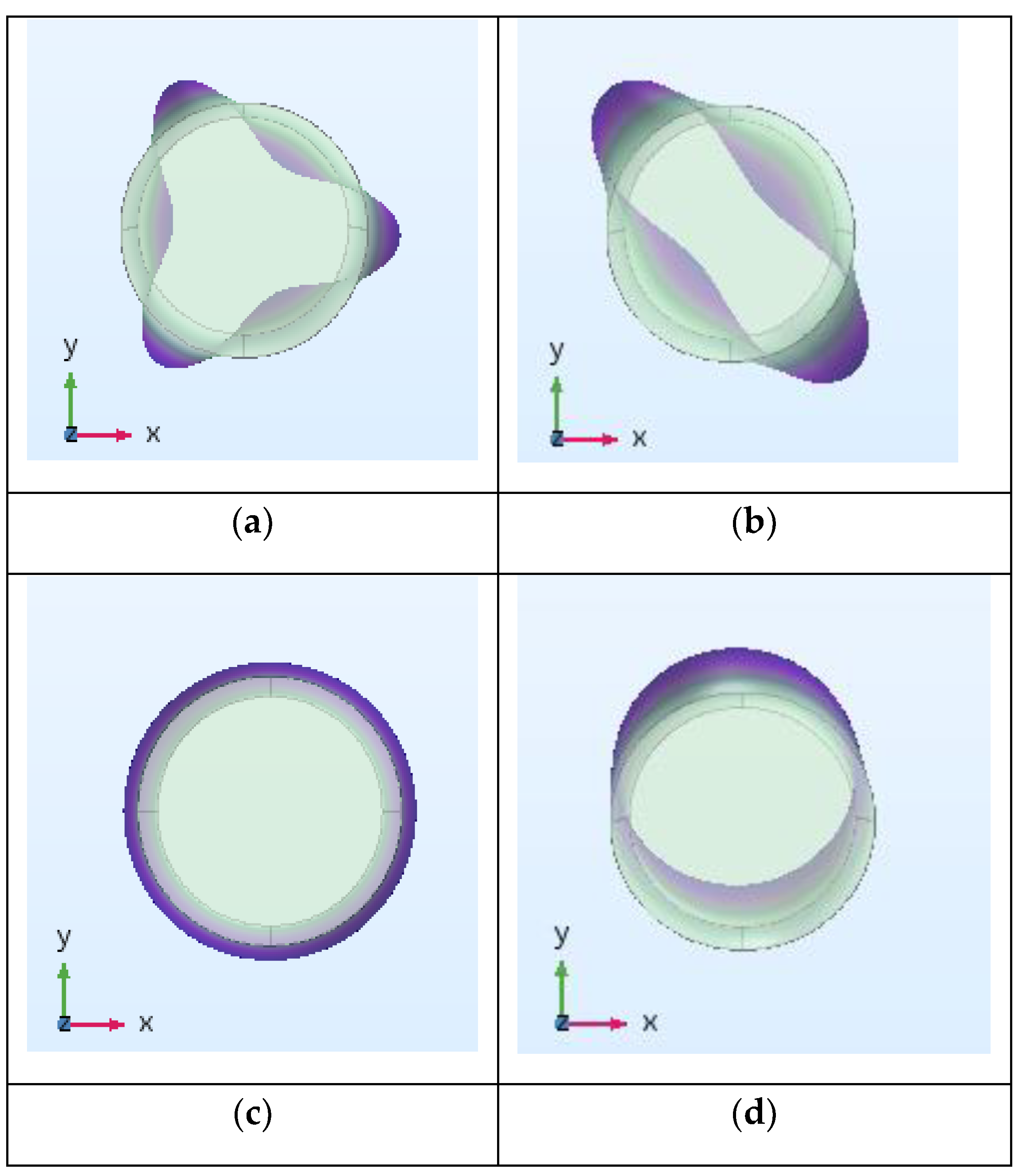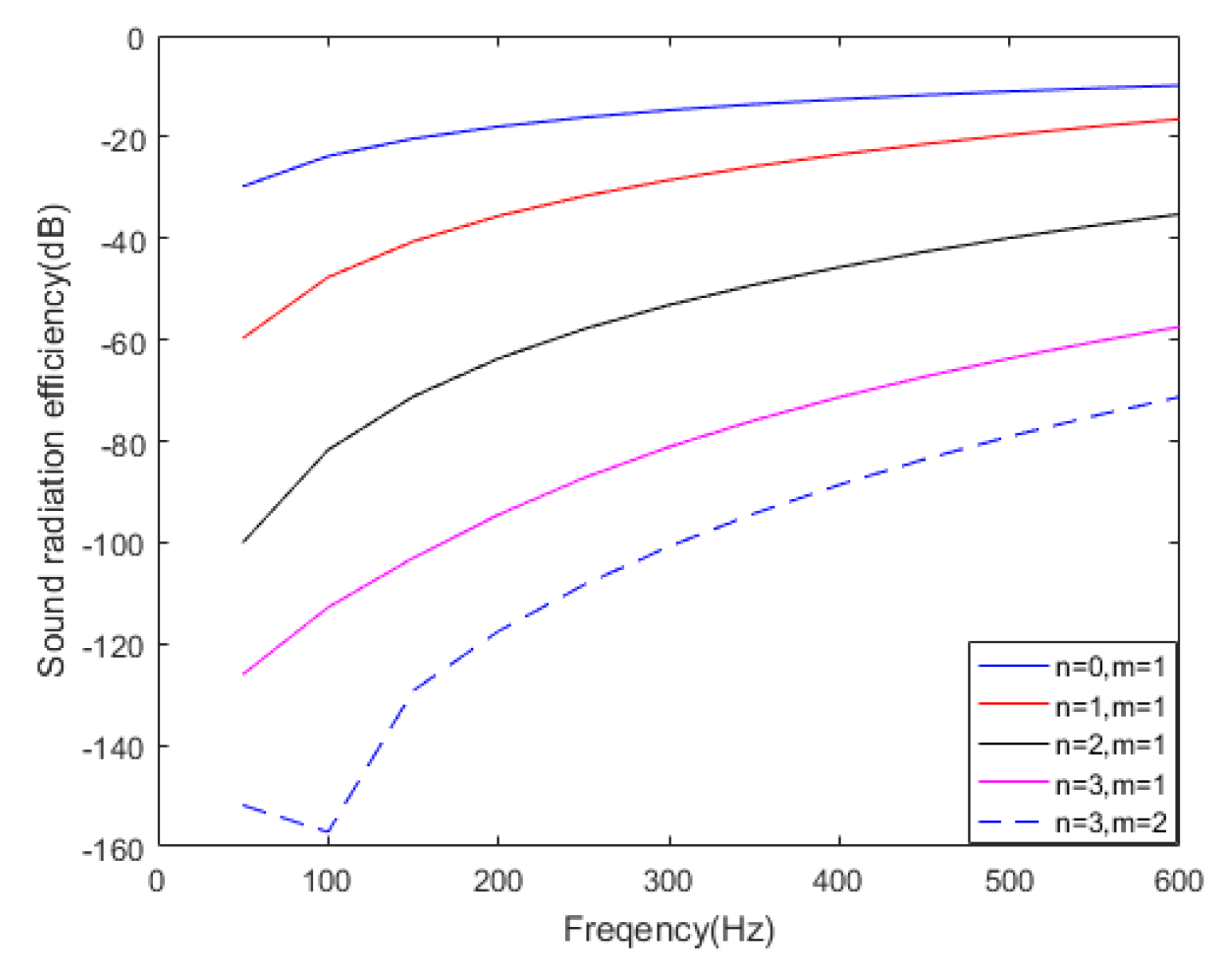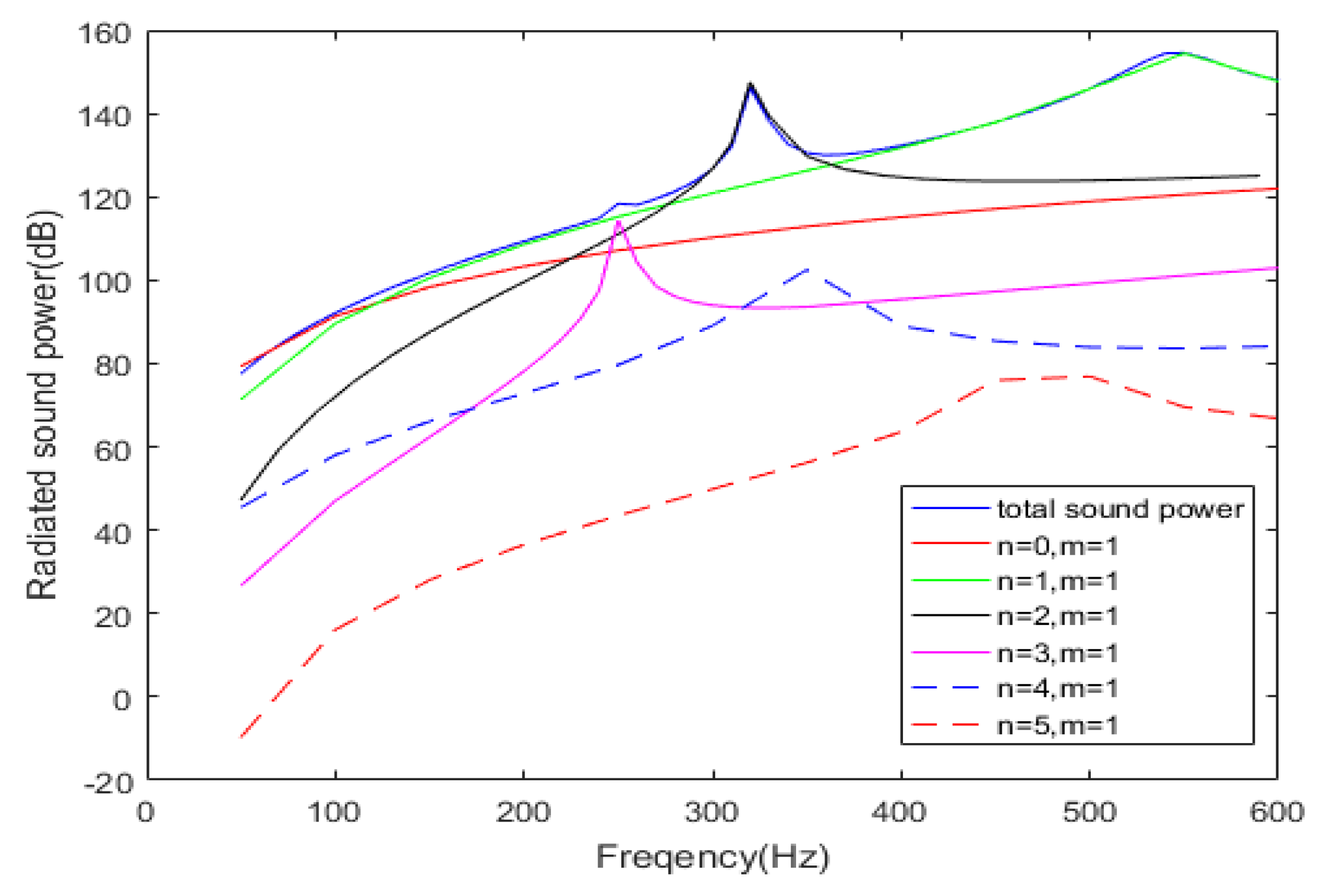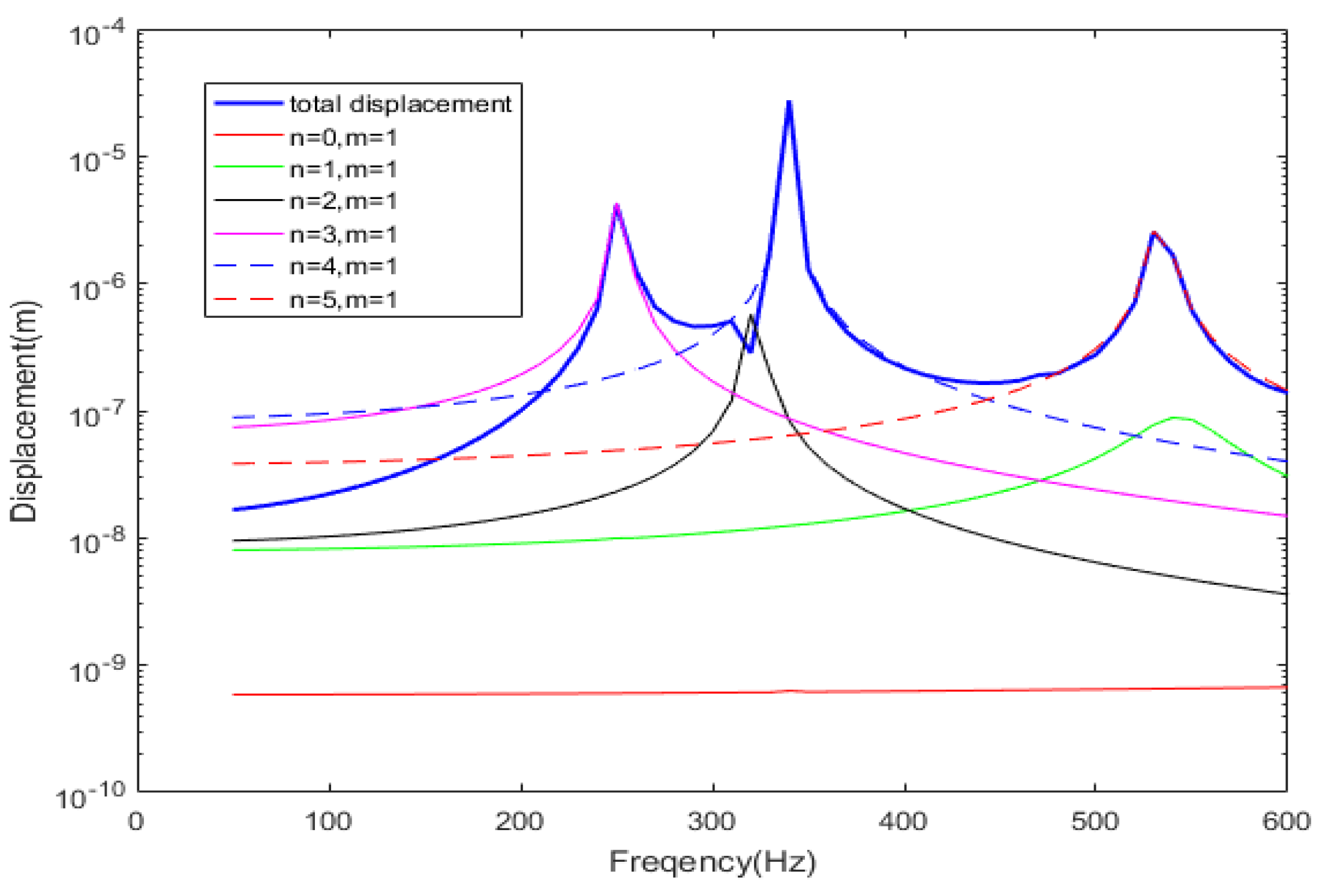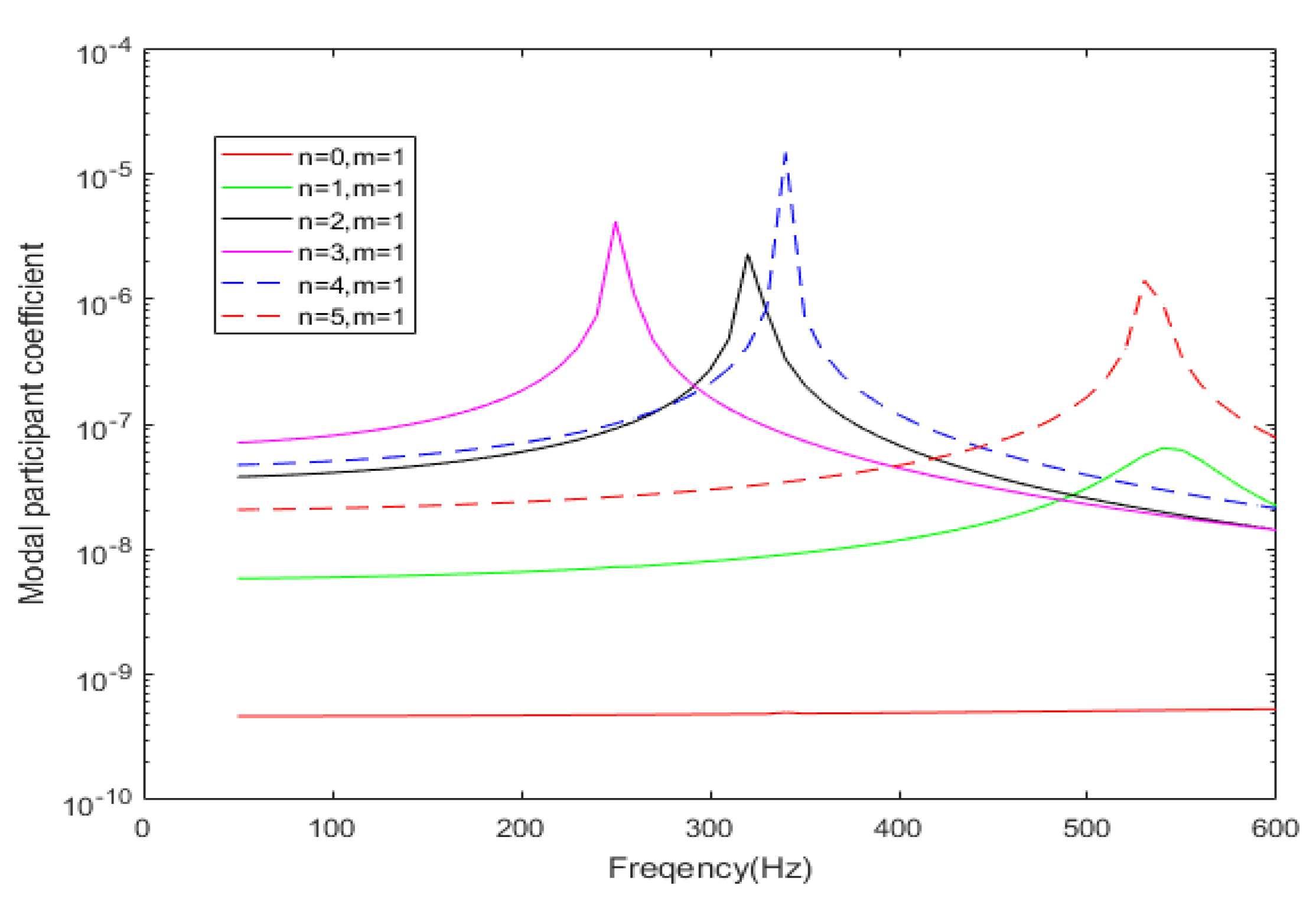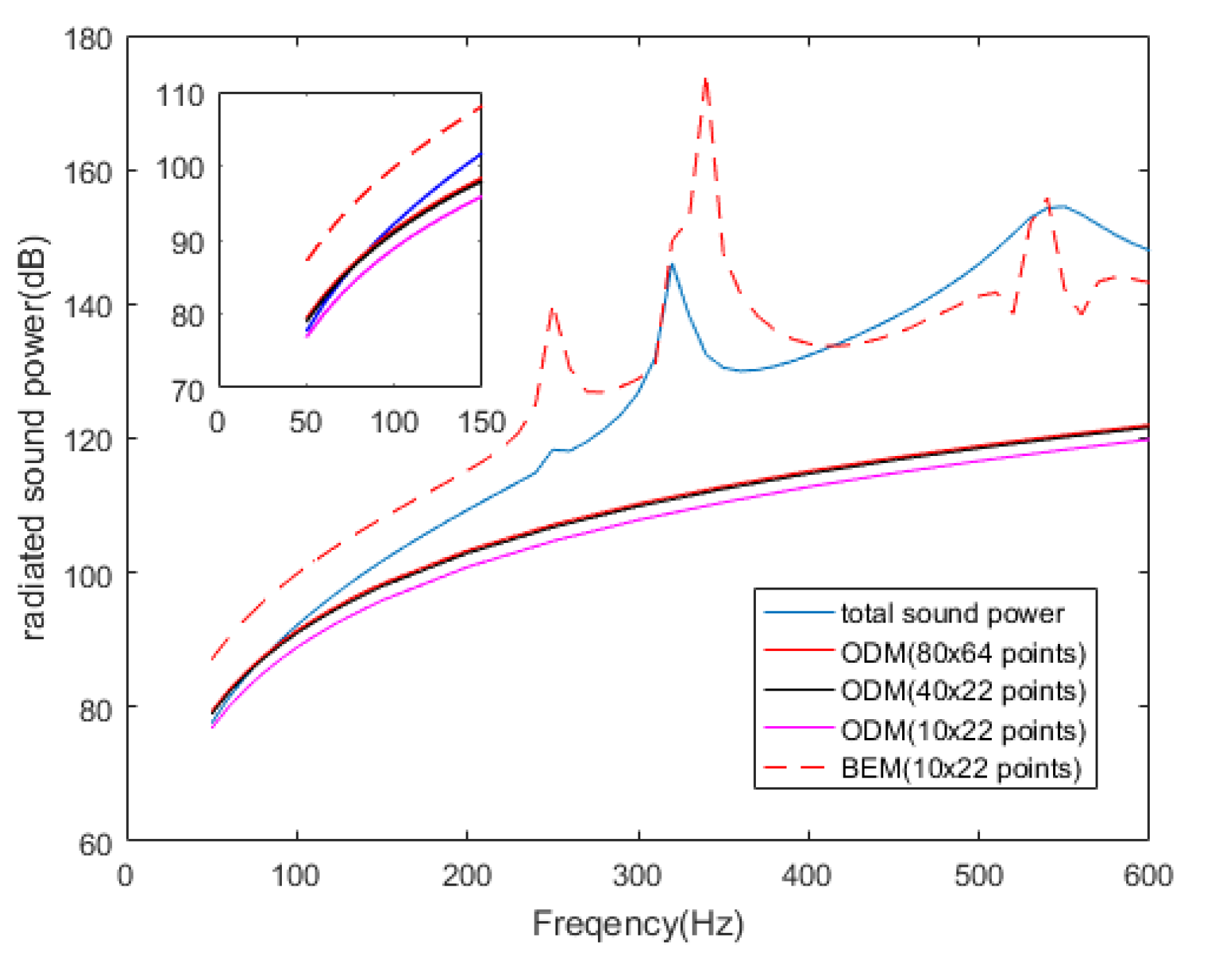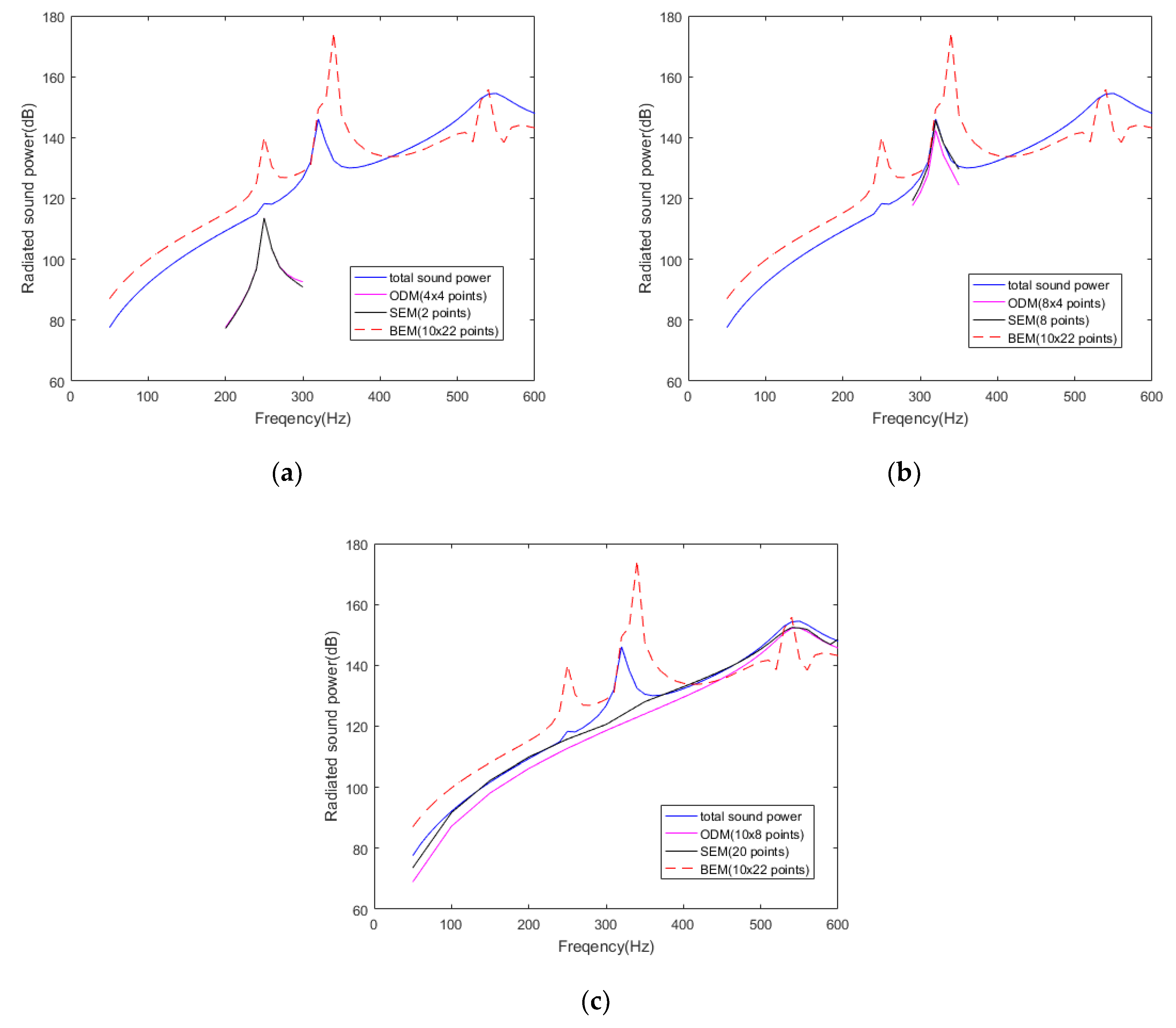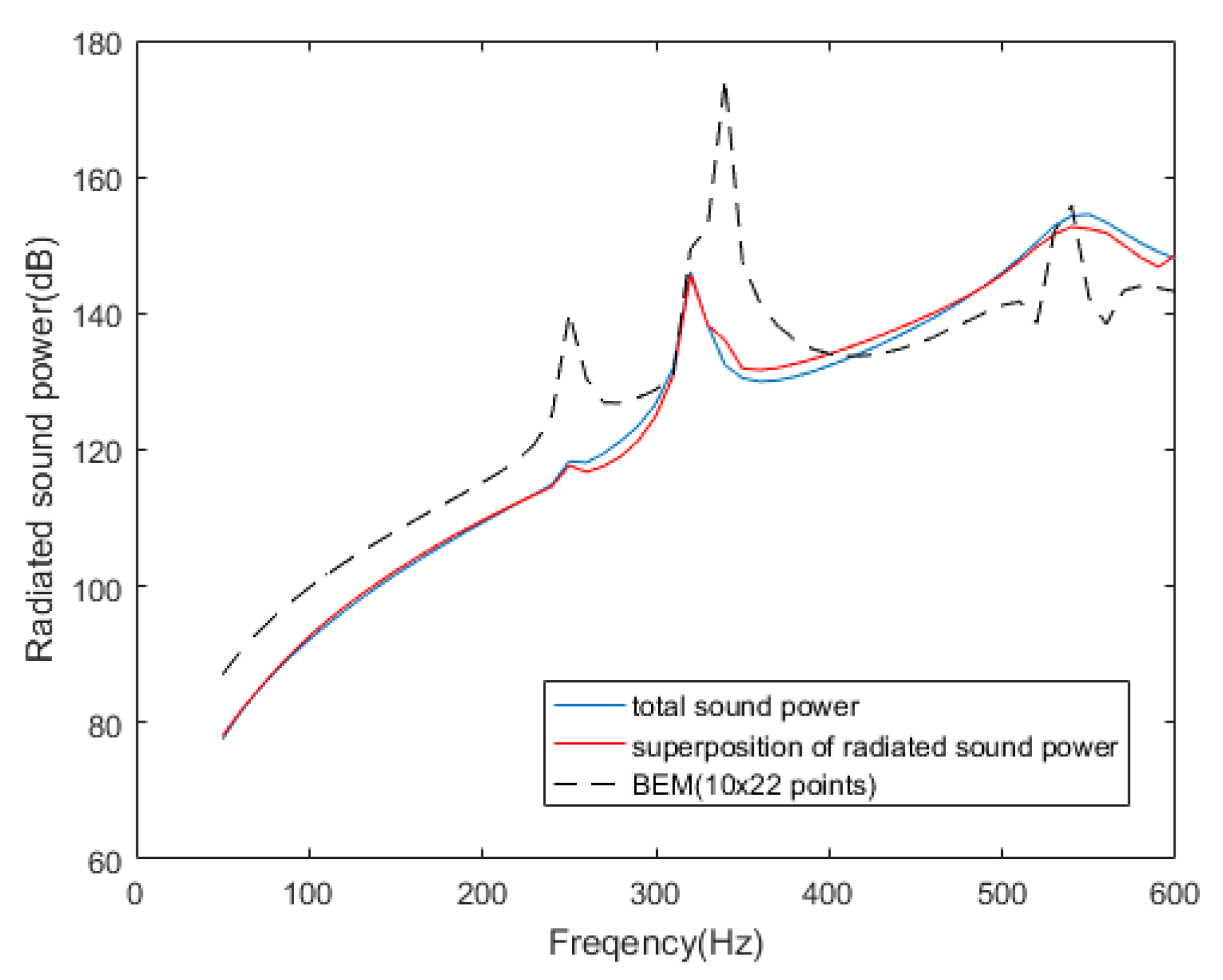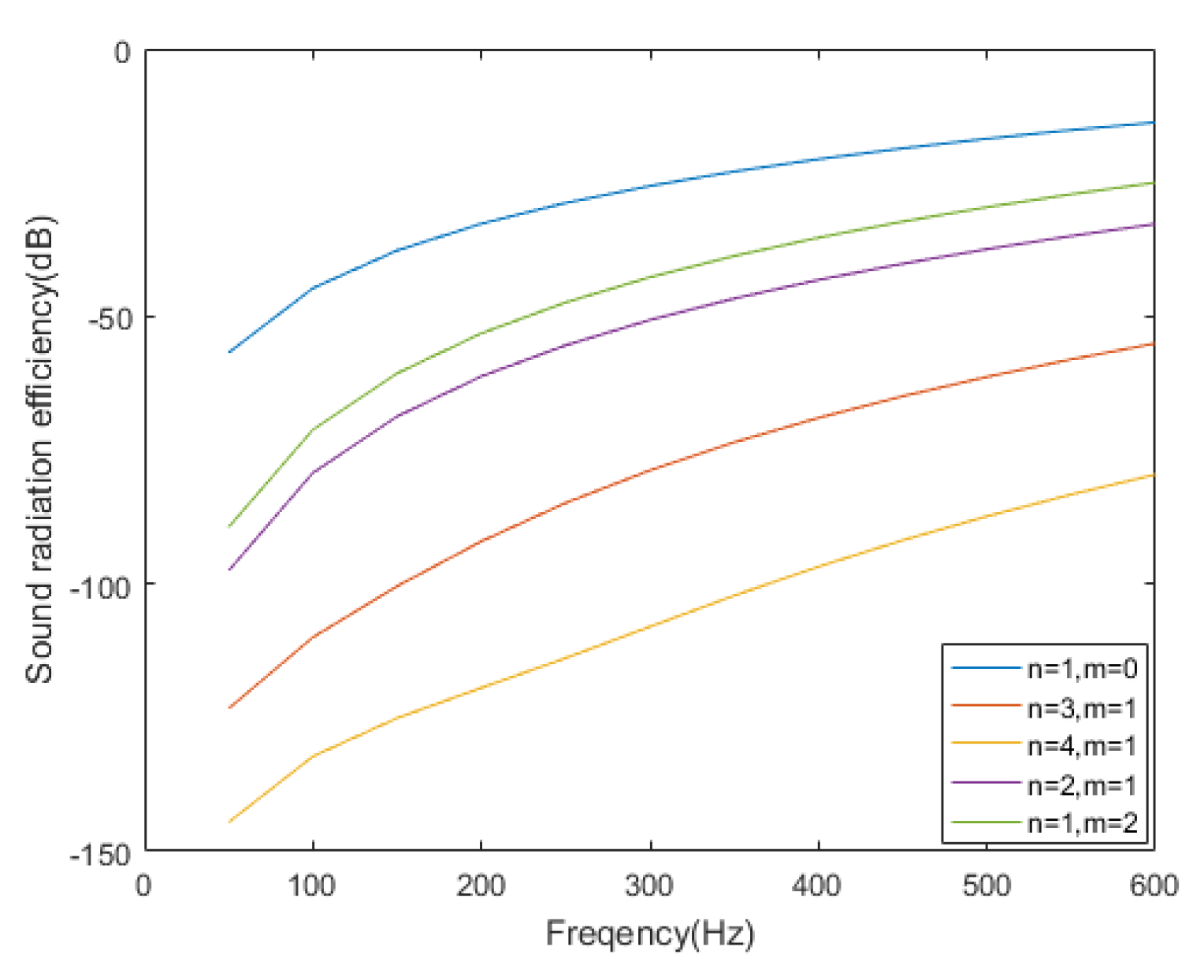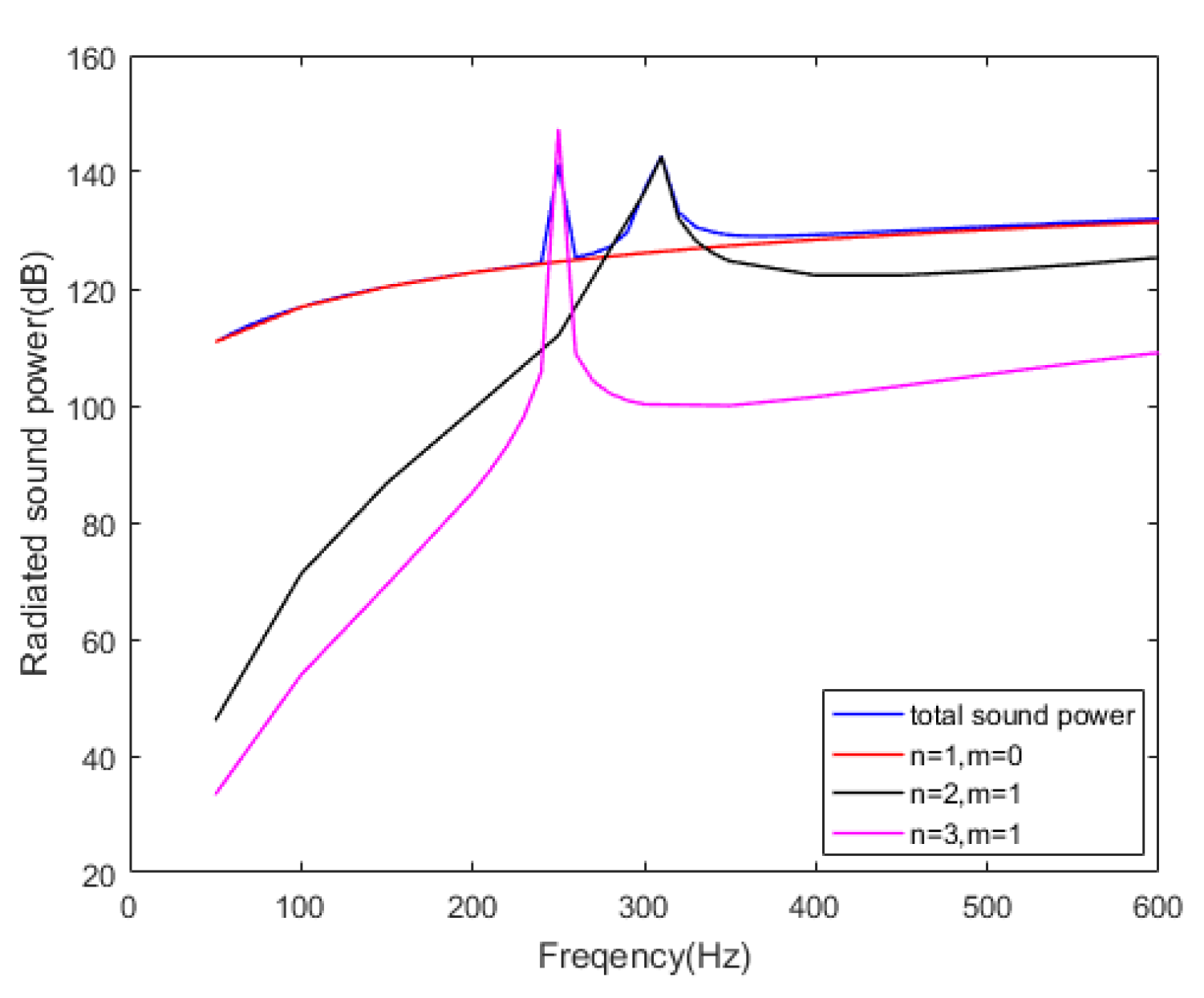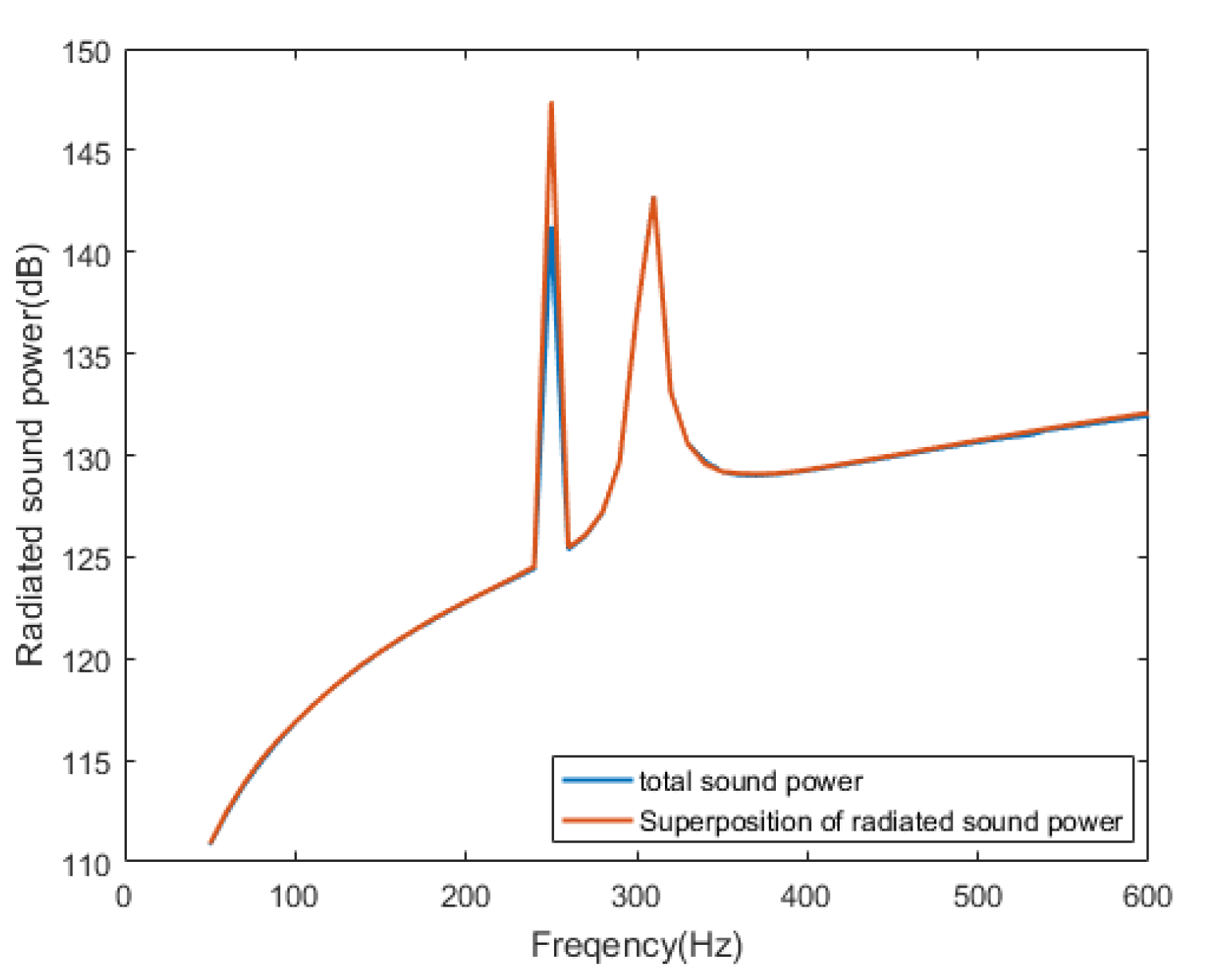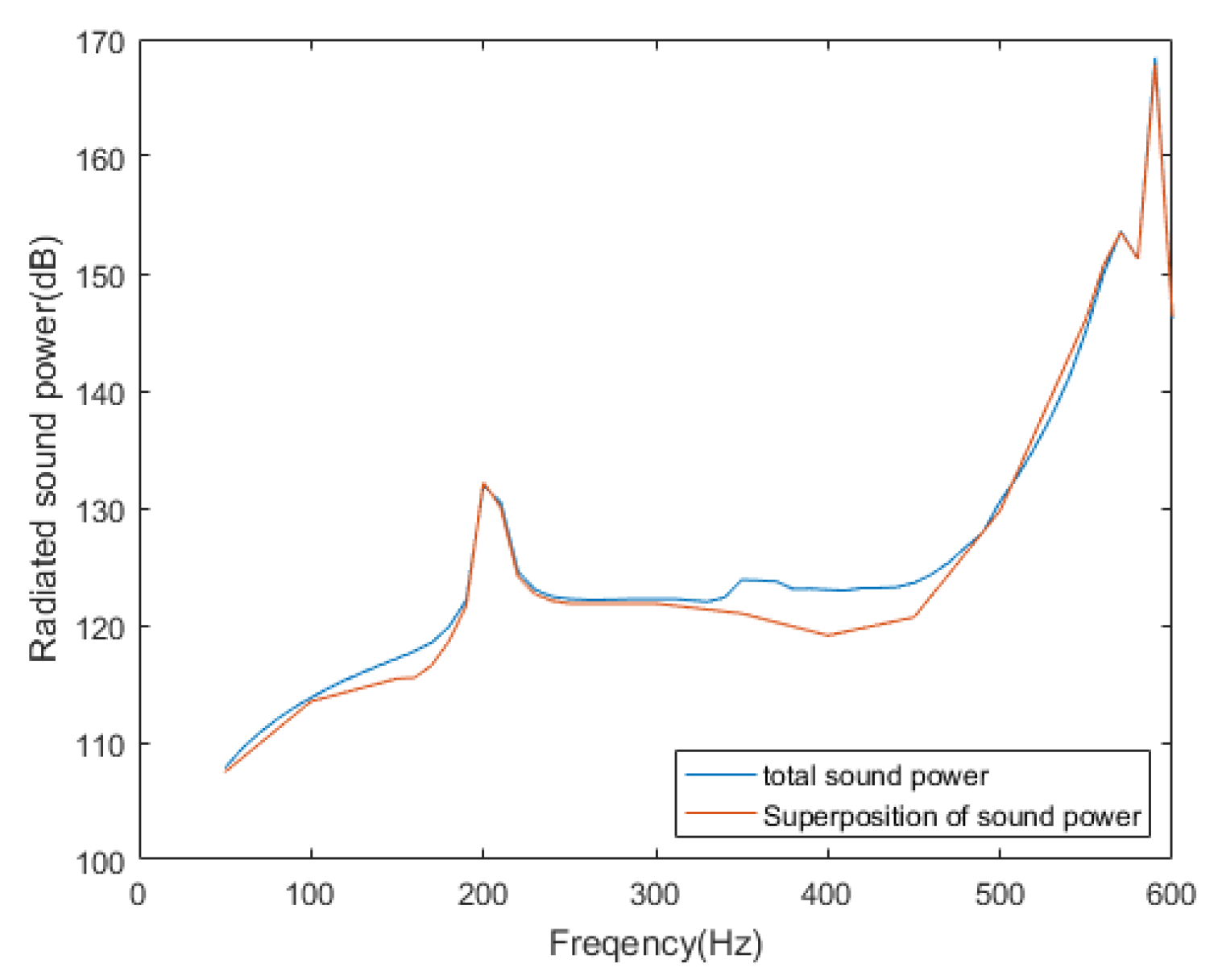1. Introduction
At present, underwater vehicles such as submarines and unmanned underwater vehicles (UUVs) are being widely used in national defense, marine development, and other fields. They are playing an increasingly important role in underwater attack, underwater defense, underwater detection, and underwater rescue. To evaluate their acoustic stealth performance and the influence of self-noise on the detection performance of local sonar, real-time and accurate prediction of radiated noise from underwater vehicles is increasingly needed. Therefore, predicting radiated noise from underwater structures has always been a concern of scholars [
1,
2,
3,
4]. Currently, the common method of predicting radiated sound from underwater structures is the prediction method using monitoring structure vibration. Another difficult problem for scholars is how to effectively reduce the number of measuring points used in the prediction and how to improve the efficiency of sound radiation prediction for the convenience of engineering applications.
The prediction of radiated sound from a vibrating structure is one of the important research fields in structural acoustics. Several classical and recognized calculation methods have been developed, such as the boundary element method (BEM) [
1], the finite element method (FEM) [
5], a method of combining BEM and FEM (FEM-BEM) [
6,
7,
8] and the equivalent source method [
9,
10]. However, these conventional approaches have their own disadvantages. The FEM and the FEM-BEM methods require a known excitation force, which is often difficult to obtain in practical engineering applications. The BEM and the equivalent source method only need to know the surface vibration of structures, but they both require the vibration information of many measuring points on the structure surface. Insufficient measuring points are the key factors that restrict the prediction accuracy in practical applications. Moreover, the prediction efficiency of these two methods is low, due to the processing of many measuring points. Thus, many researchers have made other attempts to find a better way to predict the radiated sound field.
To improve the prediction efficiency, scholars have proposed some prediction methods based on acoustic radiation modes (ARM) [
2]. In the course of carrying out research, Borgiotti [
11] identified a set of orthonormal boundary velocity patterns through the singular value decomposition, viewed as the original idea of ARM [
12,
13]. To reduce the computational cost, many papers have proposed different and simpler algorithms to calculate ARM [
14]. Some methods of applying ARM to the calculation of radiated sound power have been also proposed. Elliott and Johnson [
15] obtained two formulations for calculating the radiated sound power based on the ARM and the structural mode, respectively, and they studied the number of sensors. Some new developments have been achieved in the application of ARM. Peters et al. [
16] developed a modal decomposition technique to analyze the sound power contributed by the individual mode of a structure submerged in a heavy fluid. Haijun Wu et al. [
17] proposed a new application for the ARM: computing the sound power of structures with convex shapes based on the mapped ARM and the mapping relationship. In general, the advantage of ARM is that it improves the prediction efficiency by applying the theory of modes. However, the eigenmode of structural vibration is a structural vibration mode, thereby making it inefficient at decomposing the structure vibration by using ARM. Moreover, no general calculation software currently exists for ARM. In this situation, the calculation of ARM of a general structure is cumbersome.
Researchers have also tried other approaches to solve the problem [
18,
19]. P. Ramachandrana and S. Narayanan [
3] pointed out that statistical energy analysis (SEA) can be applied to predict the radiated sound power of a structure in the high-frequency band with high modal density. Given the theory of SEA [
20], this method could only give a statistical answer, which always has obvious uncertainty, and it is only suitable for high frequencies. Hyeongill and Rajendra [
21] described two analytical solutions based on the Rayleigh integral and based on BEM for the sound radiation of a thick annular disk with a free boundary. Zhang Qifan et al. [
22] proposed an effective approach called acoustic transfer vector (ATV) to quickly evaluate the vibro-acoustic response by saving the ATV in advance in the database. The above methods are all based on establishing the integral relationship between the surface vibration velocity and the sound field to predict the radiated sound. Therefore, they all require a large number of measuring points on the structure surface. A. Tsouvalas and A.V. Metrikine [
23] discussed a similar and complete approach for a fluid waveguide and dealt with more complicated situations. Apostolos Tsouvalas et al. [
24] discussed the sound wave radiation from the perspective of the convergence of the solution in terms of the satisfaction of the kinematics at the shell-fluid interface, and also dealt with some complex situations.
To simplify the procedure of predicting the radiated sound field and efficiently obtain the radiated sound power of the structure, a new method based on the main radiation structural modes is proposed in this paper, and this method is developed from the modal contribution idea in the ARM method. Some numerical calculations indicated that when the underwater cylindrical shell vibrates at low frequencies, a certain structural mode called dominantly radiated structural mode (DRSM) contributes dominantly to the total radiated sound power in a certain frequency bands. On the basis of this characteristic, DRSM is used to efficiently predict the radiated sound power of underwater cylindrical shells. This method is efficient because it inherits the idea of efficient ARM and obtains the radiated sound power by superposition of several DRSMs. In addition, in most frequency bands, the DRSMs contribute significantly to the vibration displacement. Therefore, the solving displacement equations method can be used during modal decomposition, and will effectively reduce the number of required measuring points. Furthermore, structural modal information of the underwater structure can be precomputed and saved in the database for the next forecast and calculation, which makes it easier to meet the real-time requirements of online prediction.
3. Simulation Analysis of Vibration and Acoustic Radiation of Cylindrical Shell
To analyze the relationship between modal radiated sound power and total sound power at low frequencies, a simulation of modal analysis and sound radiation analysis of a cylindrical shell with fixed ends is presented. The low frequency band mentioned in the article refers to the frequency band with the first few sound radiation peaks. The cylindrical shell model is shown in
Figure 1. The length of the selected cylindrical shell model is 1 m, the radius is 0.2 m, and the thickness is 0.005 m. The material of the model is steel, with a density of 7800 kg/m
3, a Young’s modulus of 2.06 × 1011 pa, a Poisson’s ratio of 0.3, and a loss factor of 0.01. COMSOL Multiphysics (a commercial FEM software) is used to calculate the cylindrical shell’s modes, the mode, and the radiated sound power.
3.1. Structural Modes of Cylindrical Shell
The modal analysis of the cylindrical shell with fixed ends can be performed by using COMSOL Multiphysics. Some modes are shown in
Figure 2. They are the structural modes of the shell in vacuum and they are easier to obtain than the modes of the shell in the water. In this picture, a dark color corresponds to a large displacement. The frequencies in the title of
Figure 2 are the modal natural frequencies. (
,
) are used to definite the mode order, where number
represents the circumferential wave numbers of the cylindrical shell, and number
represents the axial wave numbers of the cylindrical shell. Therefore, for cylindrical shells, the mode shape of a mode can be known from the
and
. Mode (0,1) is the breathing mode, mode (1,1) is the swing mode, and mode (2,1) is the squeezing mode. Compared with mode (3,1) and higher-order modes, the abovementioned modes have an obvious characteristic of overall vibration in a large area, which is why they may also have higher sound radiation efficiency and contribution of radiated sound power. These characteristics are proven in the later simulation analysis.
3.2. Sound Radiation Efficiency of Structural Modes
According to the theory of modal superposition, both the displacement of the cylindrical shell and the radiated sound field can be expressed in the form of modal superposition, as shown in Equations (1) and (4). To analyze the contribution of each structural mode to the radiated sound field, the sound radiation efficiency of each order mode needs to be analyzed.
According to the definition, radiated sound power
and mean square velocity
are easily calculated. The sound radiation efficiency
is related to radiated sound power
and mean square velocity
[
28].
After the modes of the cylindrical shell are acquired, velocity and radiated sound pressure can be simulated in COMSOL Multiphysics by taking the modal displacement as the boundary condition. Then, the radiated sound power and mean square velocity of the corresponding mode can be calculated. Finally, the radiated sound efficiency of each mode can be obtained.
The sound radiation efficiency of several modes in this case is presented in
Figure 3.
Figure 3 shows that the sound radiation efficiency of some modes is much higher than that of other modes, such as mode (0,1), mode (1,1), and mode (2,1). In addition, many calculations related to modal sound radiation efficiency show that the sound radiation efficiency of these modes is always the highest of all modes (in the low frequency band). The high sound radiation efficiency is due to the characteristic of overall vibration in a large area, as shown in
Figure 2. These modes may contribute greatly to the total radiated sound power when the structure is vibrating and radiating energy outward; these modes are the focus in the latter part of this paper.
3.3. Sound Power Contributed by Structural Modes
For the abovementioned cylindrical shell, a normal excitation force of 1N is applied at a point in the middle of the cylindrical shell. In the whole frequency band, the excitation force does not change.
The vibration displacement distribution on the surface and the radiated sound power of the cylindrical shell were calculated by using FEM software. According to the orthogonal decomposition method mentioned in
Section 2.2.1, the participant coefficient of each mode can be acquired by decomposing the vibration displacement on the surface. A detail that should be pointed out is that these modal participant coefficients are frequency-dependent. Then, according to Equation (6), the radiated sound power under the circumstance where the participant coefficient is
can be easily obtained from that under the circumstance where the participant coefficient is 1, as calculated by FEM. The results are compared with the total radiated sound power of the cylindrical shell, as shown in
Figure 4.
As can be seen from
Figure 4, the radiated sound power contributed by mode (3,1), mode (2,1), mode (0,1) and mode (1,1) are nearly equal to the total radiated sound power of the cylindrical shell in the corresponding frequency bands. These modes can be called DRSMs. For example, mode (0,1) is the DRSM in the frequency band below 100 Hz, mode (3,1) is the DRSM in the frequency band near the sound radiation peak at about 250 Hz, mode (2,1) is the DRSM in the frequency band near the sound radiation peak at about 310 Hz and mode (1,1) is the DRSM in the frequency band near the sound radiation peak at about 540 Hz. Moreover, this mode has a very high sound radiation contribution in the entire low frequency band, so it should be calculated over the entire band.
Figure 4 also shows that the contribution of other modes to the total radiated sound power is much smaller, such as mode (4,1) and mode (5,1). Significantly, the sound radiation efficiency of these DRSMs is also very high, as shown in
Figure 3, thus providing a method to preliminarily determine the DRSMs, because the high-efficiency modes are more likely to become the DRSM.
A comparison among the radiated sound power of each mode with the total radiated sound power of the cylindrical shell indicates that the sound power of several DRSMs is the main component of the total sound power at low frequencies. This characteristic prompts a new direction of sound radiation prediction. That is, as long as the radiated sound power of these DRSMs can be predicted, the total radiated sound power can be easily derived from them—this approach is the sound radiation prediction method based on the DRSMs proposed in this paper. The key to the prediction is to identify the DRSMs and obtain their participant coefficients.
3.4. Analysis of Displacement Contribution from DRSMs
The previous analysis shows that the key problem of the sound radiation prediction method based on the DRSMs is to identify the DRSMs and obtain their modal participant coefficients. The identification of the DRSMs can be realized by trial calculation in the finite element simulation and the analysis of the contribution of the structural modes to the total radiated sound power. The participant coefficients of the DRSMs can be obtained by modal decomposition based on the vibration displacement distribution of the cylindrical shell. Therefore, a reasonable modal decomposition method needs to be chosen when analyzing the contribution of each mode to the total vibration displacement.
For the previous cylindrical shell model, the modal displacement contributed by several modes at a certain point of the cylindrical shell are easily calculated and compared with the total displacement, as shown in
Figure 5.
Figure 6 shows the comparison of different modal participant coefficients in this case.
Figure 5 and
Figure 6 show that although the mode (0,1) is the DRSM in the frequency band below 100 Hz, the contribution of this mode to the total displacement of the cylindrical shell is very small and much less than that of partial modes with a large contribution, which means that the extraction of modal participant coefficients will be difficult. In the frequency band near 250 Hz, mode (3,1) is the DRSM and the main component of the vibration displacement of the cylindrical shell. In the frequency band near 320 Hz, mode (2,1) is the DRSM. For the vibration, several other modes contribute significantly to the total displacement, but the displacement contribution of the mode (2,1) still has the same level of contribution as these few other modes. Moreover, a similar situation exists in the frequency band near 550 Hz. Therefore, the acquisition of the modal participant coefficients must fully consider the differences in the contribution of the DRSMs to the total vibration displacement in the corresponding frequency band.
5. Conclusions
A new method based on the DRSMs is proposed for the underwater sound radiation of a cylindrical shell. When the cylindrical shell vibrates at low frequencies, some DRSMs exist in the corresponding frequency bands. The radiated sound power of these DRSMs can be superposed to obtain the prediction results of the total sound power. The modal decomposition can use two different methods, both of which reduce the number of measuring points. Through the modal analysis of a fixed cylindrical shell, the DRSMs exist and contribute largely to the sound radiation in their frequency band, and high-efficiency modes are more likely to become the DRSM. A further study on the modal decomposition of the same cylindrical shell shows that different DRSMs can apply different methods—the orthogonal decomposition method or the solving equations method—to solve modal coefficients, which depends on the modal participant degree in the vibration displacement. These two methods show their superiority to the BEM in terms of the number of measuring points. Moreover, the cases of the free cylindrical shell and the cylindrical shell with mass rings demonstrate the correctness and the quickness of this new prediction method. This method can efficiently lower the requirement on the number of measuring points, which is beneficial to engineering applications. Furthermore, structural modal information of the underwater structure can be precomputed and saved in the database for the next forecast, which makes it easier to meet the real-time requirements of online prediction.
When this method is used to predict the radiated sound power by superposing the sound power of the DRSMs, the mutual coupling between each order is ignored at low frequencies. This assumption is valid, because the circumferential modal coupling of the cylindrical shell is relatively weak. For other models, such as flat plate, where the mutual coupling between modes cannot be ignored, the modal coupling effect needs to be considered during modal superposition. Otherwise, it will cause a large prediction error.
